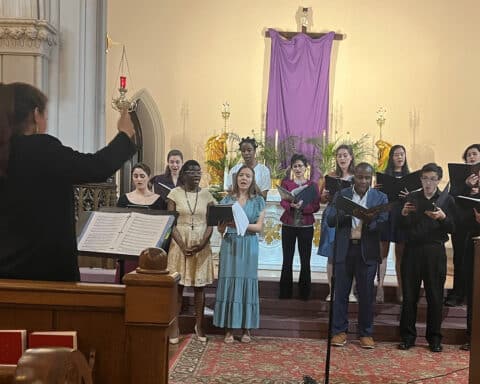Fifteen years ago, on Oct. 16, 2002, Pope St. John Paul II released his apostolic letter Rosarium Virginis Mariae (“The Rosary of the Virgin Mary”), which introduced to the Church a new set of mysteries for the Rosary to complement the traditional 15. In addition to the Joyful, Sorrowful and Glorious Mysteries, John Paul II recommended to the faithful the Luminous Mysteries, which he said brought out fully “the Christological depth of the Rosary” by including “the mysteries of Christ’s public ministry between his baptism and his passion” (No. 19). The pope said in the letter that he had no intention to curtail “the freedom of individuals and communities” to pray the Rosary as they preferred. His aim was to help the Church rediscover the beauty and power of the Rosary, which he hoped would lead to a greater practice of prayer, a closer walk with Christ and, thereby, a more lasting peace in the world, beginning within the family and spreading to society at large (see Nos. 40-41).
Inspiration for the world
Sadly, there seems to be little to no evidence that John Paul II’s hope for a transformed world through the fruit of praying the Rosary has been realized. Presently the world has experienced a disturbing antagonism between the United States and North Korea, the heartless displacement of millions of people from their homelands, and yet another senseless act of murderous violence, this time in Las Vegas. The notion of family, moreover, is in danger of becoming a mere category for census data, a convenient way to group people rather than denoting a loving communion among mother, father, children and other relatives.
In Rosarium Virginis Mariae, John Paul II laments the disintegration of the family and the “fresh scenes of bloodshed and violence” that the world witnessed at the start of the new millennium, beginning with 9/11 (No. 6). He urged people to use the Rosary as a tool to counteract such inhumanity. When prayed well, he said, the Rosary not only disposes people to the plan of God — which is nothing less than the salvation of the world that brings to fulfillment the peace and love won by Christ — but also prepares people to actively participate in God’s plan by practicing charity and being peacemakers here and now (see No. 40). The pope ends his apostolic letter with a heartfelt supplication: “May this appeal of mine not go unheard!” (No. 43).
The old saying, “Better late than never,” surely applies here. Yet, one may ask how exactly does praying the Rosary enable one to share with others God’s gifts of salvific love and peace? Certainly not merely by reciting the prayers and mysteries, as if it were some kind of magical formula. The person who prays the Rosary will bear fruit insomuch as he or she assimilates and actualizes the Christian virtues that the Rosary puts forward. The Rosary assists people in this assimilation process by providing a model and a method for putting on the mind of Christ.
A model
The model is Mary, and the primary lesson she shares — not only for people who want to pray the Rosary, but also for everyone — is that transforming the world according to God’s plan begins by being docile to God’s word. Or to put it more bluntly: If you want to change the world, you first have to change yourself. Long before giving birth to Jesus, Mary was listening to and pondering God’s word. She then conformed her actions to what she had perceived through prayer. Mary sought God’s will and worked to align her will with his. A great danger to one’s life is to do the opposite: trying to manipulate God’s will to match one’s own. Hence the importance of listening to God first.
| The Luminous Mysteries |
|---|
|
– The Baptism of Jesus in the Jordan (Mt 3:17 and parallels)
– The Wedding at Cana (Jn 2:1-12)
– The proclamation of the kingdom of God (Mk 1:15; 2:3-13)
– The Transfiguration (Lk 9:35 and parallels)
– The Institution of the Eucharist (Jn 13:1)
|
As a faithful and practicing Jew, Mary was immersed in the Hebrew Scriptures. The few times her words are recorded in the New Testament, Mary reveals a familiarity with the Biblical tradition; it is something she had read and thought about, as her allusions to the Bible demonstrate. Therefore, when God makes his word known to her, that he wants her to bear his son, she is ready to receive his message. Notice, moreover, that the way Mary receives God’s word honors both his divine majesty and her God-given dignity. She is not a blind follower. Rather, she gives God’s request, which to say the least is far from ordinary, the consideration it deserves. Her question — “How can this be, since I have no relations with a man?” — is entirely appropriate. Mary is not doubting that God’s word can be fulfilled. Much less is she trying to trap God. Quite the contrary, she is making the effort to understand him. As John Paul II wrote in Rosarium Virginis Mariae, Mary models how people can respond to the word of God: “to ask humbly the questions which open us to the light, in order to end with the obedience of faith” (No. 14). Once Mary has come to an understanding of God’s will, she gives her assent.
Mary’s “yes” to God cooperates with his plan, with the result that Jesus becomes man and enters the world, leading not only to Mary’s salvation but also to everyone’s (see Lk 1:46-55). The peace and love of God break into the world in the most personal and glorious way: by God’s own real presence. What more could anyone hope for?
Mary’s “yes” also affects her and every human person in another way: She becomes an eyewitness to the events of Jesus’ life. One could say, as John Paul II did (No. 11), that she contemplated the mysteries of the Rosary as they happened, and thereby she became both a disciple of her son and a teacher to his other disciples. Since, as the Church proclaims, Mary is alive in Christ even now, she continues to pray with and for humanity. Her most compact and profound advice was precisely the fruit of prayer, and it remains an integral part of Christian discipleship today: “Do whatever he tells you” (Jn 2:5).
In effect, Mary invites everyone to participate in God’s plan just as she did. Everyone can listen now to the word of God, ponder its meaning, question it with humility and end in the obedience of faith that leads to the transformation of one’s self and the world. As John Paul II put it: “Mary constantly sets before the faithful the ‘mysteries’ of her Son, with the desire that the contemplation of those mysteries will release all their saving power” (No. 11).
A Method
So that people may pray with Mary, John Paul II also suggests a method for praying the Rosary. Note that it is “a method” and not “the method.” The aim of all Christian prayer is less about technique and more about encountering Christ and getting to know him (see No. 14). Although the Rosary is structured upon the major moments of Jesus’ life, it is not a nostalgic exercise. The events of Jesus’ life “not only belong to ‘yesterday’; they are also part of the ‘today’ of salvation” through the grace that continues to pour forth from them (No. 13). Moreover, grounding the whole practice of prayer is the belief that Jesus remains with the world not only through the sacraments (pre-eminently in the Eucharist), but also, in no less a real way, through one’s relationship with him and with others.
John Paul II wrote that “we should not be surprised that our relationship with Christ makes use of a method” (No. 27). Human beings are flesh-and-blood animals. Yes, they are made in the image and likeness of God, but they still approach God as creatures. Therefore, the Rosary “engages the whole person in all his complex psychological, physical and relational reality” (No. 27). Hence, the method that John Paul II offers in Rosarium Virginis Mariae is similar to the traditional way of praying the Rosary. One can still make use of beads. It still includes all the familiar prayers. The change that John Paul II recommends — besides the inclusion of the Luminous Mysteries — has more to do with pace, attention and follow-through.
John Paul II wants to protect the Rosary as a valid method of contemplation and guard against it becoming an end in itself (No. 28). Moreover, he warns against the easy slip into a “hurried recitation” of the Rosary, which can dull the mind to the reception of the mysteries (No. 33). In order to benefit from his method, John Paul II writes that one must approach the Rosary in a spirit of love, just as Mary did as she lived with her son and pondered his activities (No. 26).
The method that the pope recommends consists of three important exercises in support of the traditional practices: the need for concreteness, the need to listen to the word of God and the need for silence.
By concreteness, John Paul II means “to open up a scenario on which to focus our attention” (No. 29). It can be done, among other ways, by announcing aloud the particular mystery to be contemplated or by using an icon that portrays the mystery. Concreteness helps to concentrate “the mind on the particular mystery.” It involves the use of one’s senses, which reminds one who prays that one’s entire being — body and soul — is ordered toward God. Concreteness also reminds one that the physical senses are good and correspond “to the inner logic of the Incarnation.” The aim is to open oneself to the ever-present saving power of Jesus’ actions, which continues to spread throughout space and time.
The need to listen to God’s word is essential to being a participant in his plan. Therefore, John Paul II suggests that after announcing the mystery, “the proclamation of a related Biblical passage” should follow. Both Jesus and Mary are models of listening to the word of God, motivated by their love for the Father and the desire to do his will. Like them, the one who prays the Rosary with love will receive the word of God not merely as information, but as a message “spoken for today and spoken ‘for me'” (No. 30). In any relationship, the importance of listening cannot be understated. If a person desires to hear God and to know his will, a continued effort at attentive listening is crucial. Such listening includes the humble and faithful questioning that Mary practiced and that leads to obedience.
John Paul II wrote that a period of silence should follow the announcement of the mystery and the proclamation of the word of God. Back in 2002, he commented that a “drawback of a society dominated by technology and the mass media is the fact that silence becomes increasingly difficult to achieve” (No. 31). Fifteen years hence, society has only increased its dependence on cellphones, tablets and digital media. Distractions continue to be a stumbling block for people in their relationship with God and with each other. To receive God’s word clearly, one needs to remove the “noise” of other voices and concerns in order to hear God speak (if he so chooses), just as Elijah learned during his interaction with God (see 1 Kgs 19:11-ff).
Changing the world
By bringing the events of Jesus concretely to mind, by listening to the word of God and by maintaining silence in order to give these mysteries “space” in one’s life, one is prepared to enter the prayer of the Rosary ready to receive the gifts that God may bestow. As one continues with the Our Father, the Hail Mary’s, and the Gloria, one is joined to Mary in prayer and centered on Christ. Over time, the praying of the rosary – offered attentively, with love and with openness to God – can become an agent of change in one’s life. The rosary helps one to assimilate the virtues of Christ, even as sharing Jesus’ life did the same for Mary.
John Paul II passed on a quote from Blessed Bartolo Longo that explains the assimilation process well (and which Bartolo practiced, being transformed from an unbeliever to a faithful follower of Jesus): “Just as two friends, frequently in each other’s company, tend to develop similar habits, so too, by holding familiar converse with Jesus and the Blessed Virgin, by meditating on the mysteries of the Rosary and by living the same life in holy Communion, we can become, to the extent of our lowliness, similar to them and can learn from these supreme models a life of humility, poverty, hiddenness, patience and perfection” (No. 15).
Given the transformation that can happen in one’s life by praying the Rosary with Mary as one’s model and by using John Paul II’s method, one can understand why John Paul II was convinced that it would lead to a wider experience of God’s love and peace won by Christ. If individuals change their lives, practicing charity and working for peace in their relationships, then the possibility of positive change in society increases dramatically. Certainly the world has seen the opposite: Individuals filled with hate and greed have created disharmony and contaminated society with the effects of their sins. All the more reason to heed John Paul’s appeal to pray the Rosary with love for God and a desire to cooperate with his plan. If people do so, then, like Mary, they will change the world by changing themselves.





